Operations and Project Management: Land Rover and Midland Project
VerifiedAdded on 2021/02/21
|12
|3740
|260
Project
AI Summary
This project management report delves into operations and project management, utilizing Land Rover and Midland as case studies. The report begins with an introduction to operations management, followed by a review and critique of its implementation within Land Rover, focusing on principles like reality, organization, fundamentals, and accountability. It then prepares a continuous improvement plan, incorporating lean principles such as defining value, mapping value streams, creating flow, establishing pull, and pursuing perfection. The second project applies the project life cycle (PLC) to a Midland case study, outlining each stage and creating necessary documentation for an on-site canteen project. The report also reviews and critiques operations management theories to ensure cost-effectiveness. The analysis encompasses the extent to which operations management fulfills customer demands and emphasizes continuous improvement as a crucial philosophy.
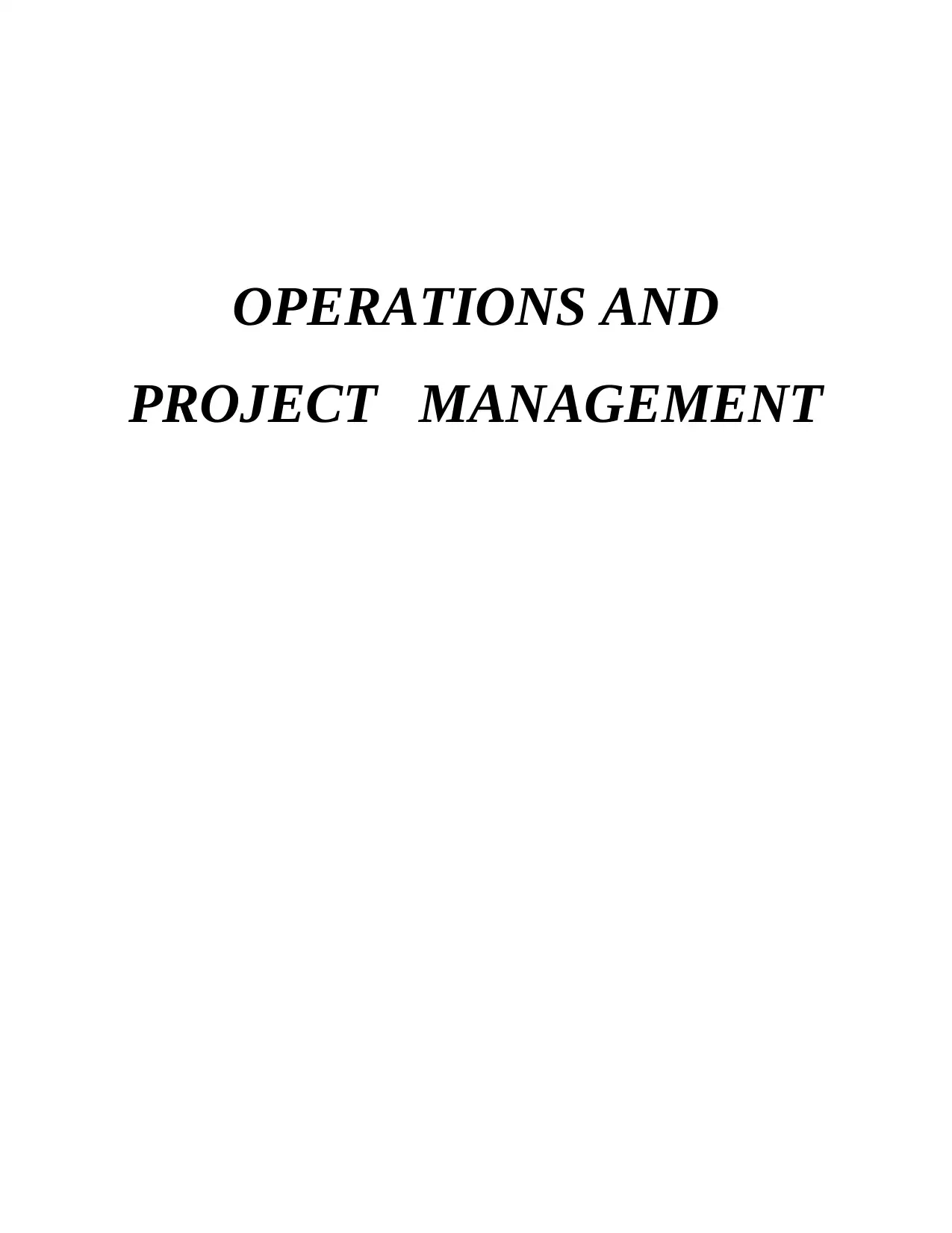
OPERATIONS AND
PROJECT MANAGEMENT
PROJECT MANAGEMENT
Paraphrase This Document
Need a fresh take? Get an instant paraphrase of this document with our AI Paraphraser
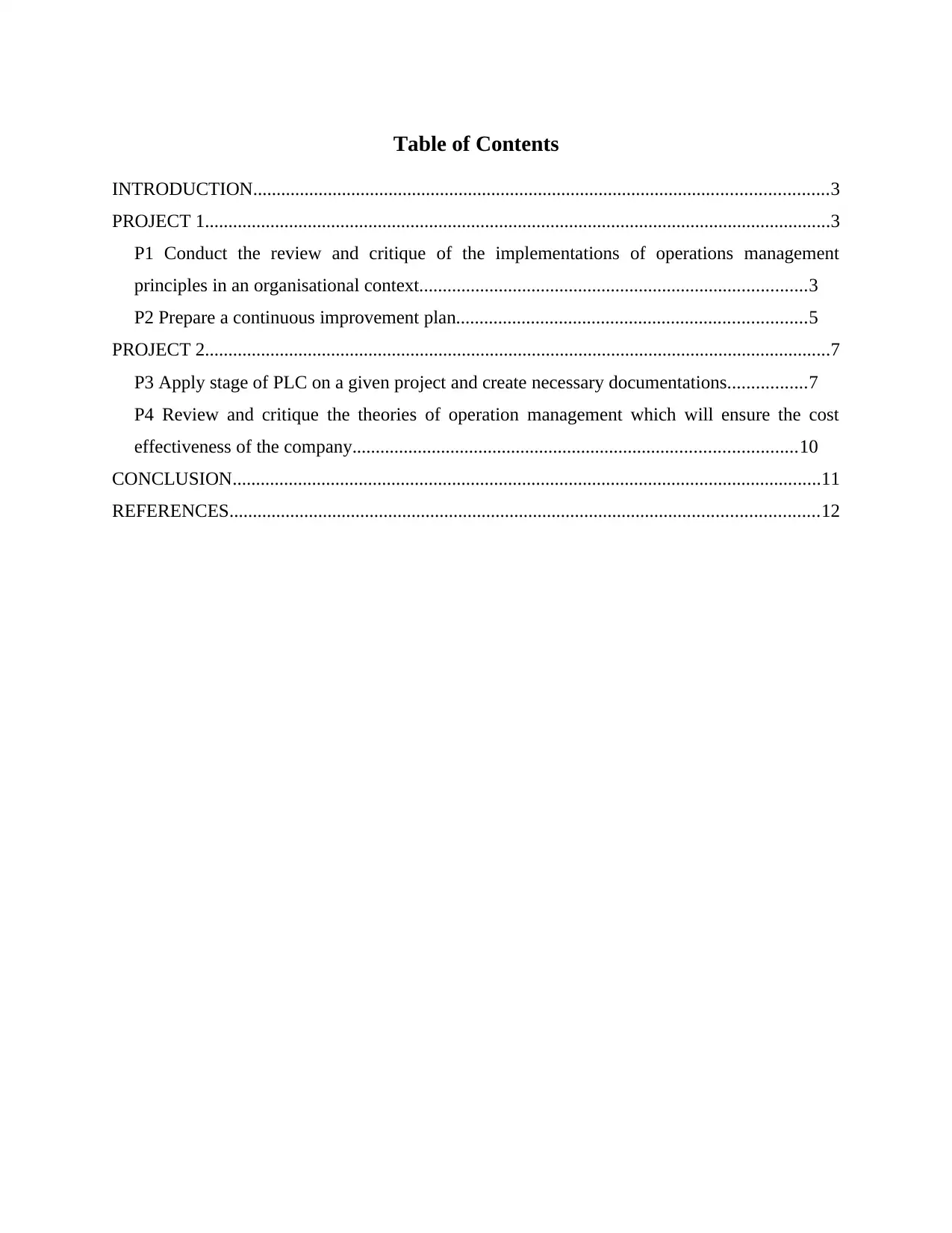
Table of Contents
INTRODUCTION...........................................................................................................................3
PROJECT 1......................................................................................................................................3
P1 Conduct the review and critique of the implementations of operations management
principles in an organisational context...................................................................................3
P2 Prepare a continuous improvement plan...........................................................................5
PROJECT 2......................................................................................................................................7
P3 Apply stage of PLC on a given project and create necessary documentations.................7
P4 Review and critique the theories of operation management which will ensure the cost
effectiveness of the company...............................................................................................10
CONCLUSION..............................................................................................................................11
REFERENCES..............................................................................................................................12
INTRODUCTION...........................................................................................................................3
PROJECT 1......................................................................................................................................3
P1 Conduct the review and critique of the implementations of operations management
principles in an organisational context...................................................................................3
P2 Prepare a continuous improvement plan...........................................................................5
PROJECT 2......................................................................................................................................7
P3 Apply stage of PLC on a given project and create necessary documentations.................7
P4 Review and critique the theories of operation management which will ensure the cost
effectiveness of the company...............................................................................................10
CONCLUSION..............................................................................................................................11
REFERENCES..............................................................................................................................12
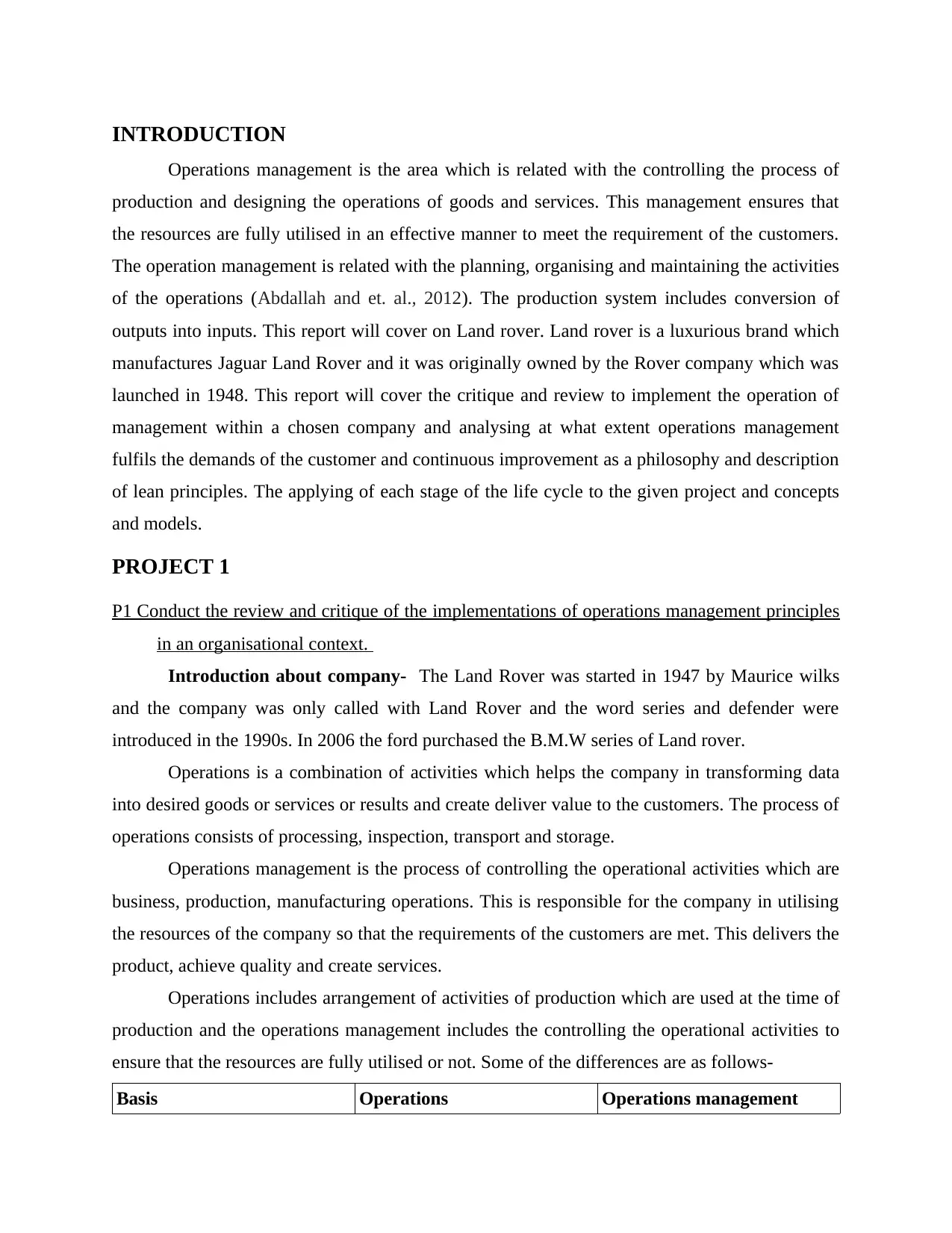
INTRODUCTION
Operations management is the area which is related with the controlling the process of
production and designing the operations of goods and services. This management ensures that
the resources are fully utilised in an effective manner to meet the requirement of the customers.
The operation management is related with the planning, organising and maintaining the activities
of the operations (Abdallah and et. al., 2012). The production system includes conversion of
outputs into inputs. This report will cover on Land rover. Land rover is a luxurious brand which
manufactures Jaguar Land Rover and it was originally owned by the Rover company which was
launched in 1948. This report will cover the critique and review to implement the operation of
management within a chosen company and analysing at what extent operations management
fulfils the demands of the customer and continuous improvement as a philosophy and description
of lean principles. The applying of each stage of the life cycle to the given project and concepts
and models.
PROJECT 1
P1 Conduct the review and critique of the implementations of operations management principles
in an organisational context.
Introduction about company- The Land Rover was started in 1947 by Maurice wilks
and the company was only called with Land Rover and the word series and defender were
introduced in the 1990s. In 2006 the ford purchased the B.M.W series of Land rover.
Operations is a combination of activities which helps the company in transforming data
into desired goods or services or results and create deliver value to the customers. The process of
operations consists of processing, inspection, transport and storage.
Operations management is the process of controlling the operational activities which are
business, production, manufacturing operations. This is responsible for the company in utilising
the resources of the company so that the requirements of the customers are met. This delivers the
product, achieve quality and create services.
Operations includes arrangement of activities of production which are used at the time of
production and the operations management includes the controlling the operational activities to
ensure that the resources are fully utilised or not. Some of the differences are as follows-
Basis Operations Operations management
Operations management is the area which is related with the controlling the process of
production and designing the operations of goods and services. This management ensures that
the resources are fully utilised in an effective manner to meet the requirement of the customers.
The operation management is related with the planning, organising and maintaining the activities
of the operations (Abdallah and et. al., 2012). The production system includes conversion of
outputs into inputs. This report will cover on Land rover. Land rover is a luxurious brand which
manufactures Jaguar Land Rover and it was originally owned by the Rover company which was
launched in 1948. This report will cover the critique and review to implement the operation of
management within a chosen company and analysing at what extent operations management
fulfils the demands of the customer and continuous improvement as a philosophy and description
of lean principles. The applying of each stage of the life cycle to the given project and concepts
and models.
PROJECT 1
P1 Conduct the review and critique of the implementations of operations management principles
in an organisational context.
Introduction about company- The Land Rover was started in 1947 by Maurice wilks
and the company was only called with Land Rover and the word series and defender were
introduced in the 1990s. In 2006 the ford purchased the B.M.W series of Land rover.
Operations is a combination of activities which helps the company in transforming data
into desired goods or services or results and create deliver value to the customers. The process of
operations consists of processing, inspection, transport and storage.
Operations management is the process of controlling the operational activities which are
business, production, manufacturing operations. This is responsible for the company in utilising
the resources of the company so that the requirements of the customers are met. This delivers the
product, achieve quality and create services.
Operations includes arrangement of activities of production which are used at the time of
production and the operations management includes the controlling the operational activities to
ensure that the resources are fully utilised or not. Some of the differences are as follows-
Basis Operations Operations management
⊘ This is a preview!⊘
Do you want full access?
Subscribe today to unlock all pages.

Trusted by 1+ million students worldwide
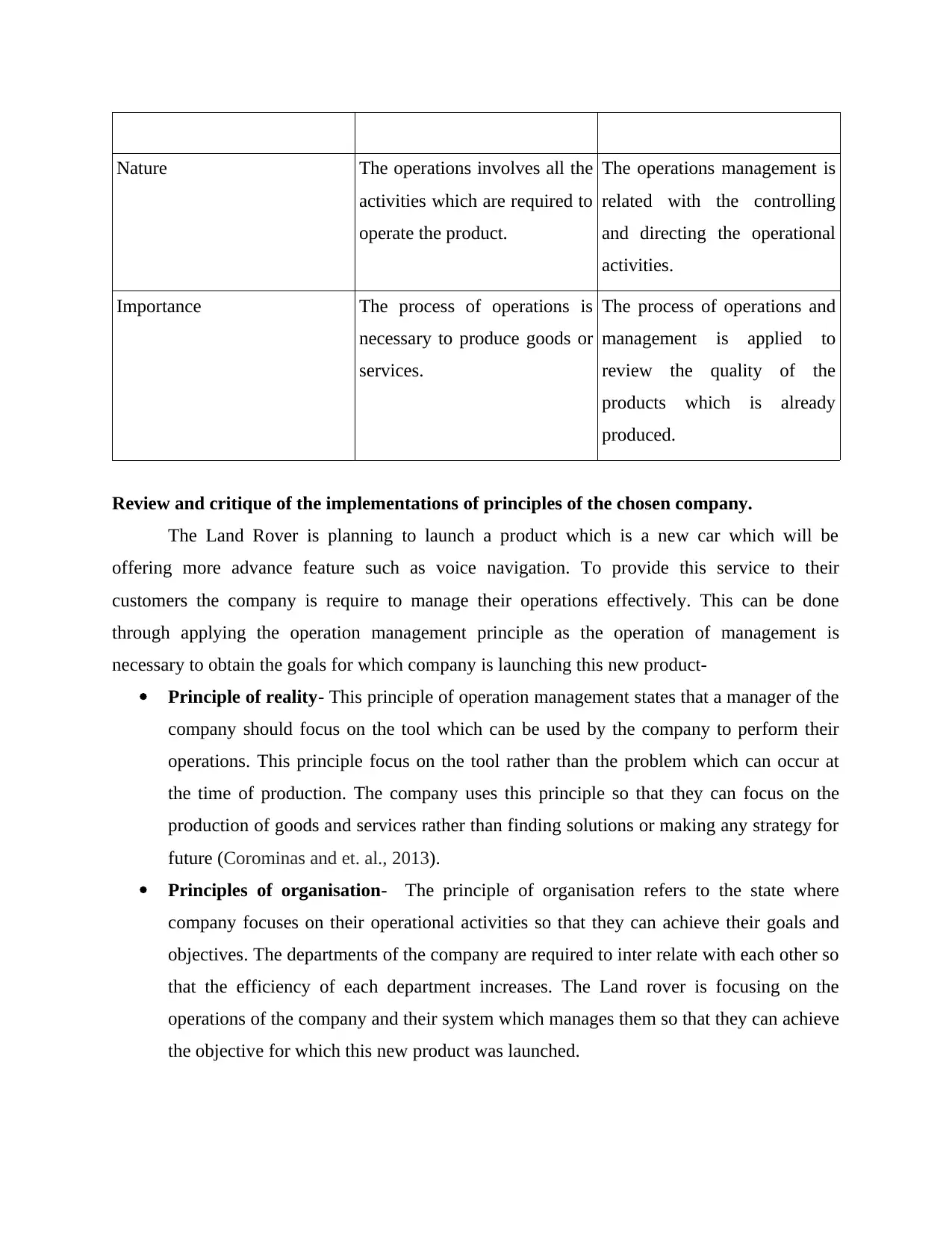
Nature The operations involves all the
activities which are required to
operate the product.
The operations management is
related with the controlling
and directing the operational
activities.
Importance The process of operations is
necessary to produce goods or
services.
The process of operations and
management is applied to
review the quality of the
products which is already
produced.
Review and critique of the implementations of principles of the chosen company.
The Land Rover is planning to launch a product which is a new car which will be
offering more advance feature such as voice navigation. To provide this service to their
customers the company is require to manage their operations effectively. This can be done
through applying the operation management principle as the operation of management is
necessary to obtain the goals for which company is launching this new product-
Principle of reality- This principle of operation management states that a manager of the
company should focus on the tool which can be used by the company to perform their
operations. This principle focus on the tool rather than the problem which can occur at
the time of production. The company uses this principle so that they can focus on the
production of goods and services rather than finding solutions or making any strategy for
future (Corominas and et. al., 2013).
Principles of organisation- The principle of organisation refers to the state where
company focuses on their operational activities so that they can achieve their goals and
objectives. The departments of the company are required to inter relate with each other so
that the efficiency of each department increases. The Land rover is focusing on the
operations of the company and their system which manages them so that they can achieve
the objective for which this new product was launched.
activities which are required to
operate the product.
The operations management is
related with the controlling
and directing the operational
activities.
Importance The process of operations is
necessary to produce goods or
services.
The process of operations and
management is applied to
review the quality of the
products which is already
produced.
Review and critique of the implementations of principles of the chosen company.
The Land Rover is planning to launch a product which is a new car which will be
offering more advance feature such as voice navigation. To provide this service to their
customers the company is require to manage their operations effectively. This can be done
through applying the operation management principle as the operation of management is
necessary to obtain the goals for which company is launching this new product-
Principle of reality- This principle of operation management states that a manager of the
company should focus on the tool which can be used by the company to perform their
operations. This principle focus on the tool rather than the problem which can occur at
the time of production. The company uses this principle so that they can focus on the
production of goods and services rather than finding solutions or making any strategy for
future (Corominas and et. al., 2013).
Principles of organisation- The principle of organisation refers to the state where
company focuses on their operational activities so that they can achieve their goals and
objectives. The departments of the company are required to inter relate with each other so
that the efficiency of each department increases. The Land rover is focusing on the
operations of the company and their system which manages them so that they can achieve
the objective for which this new product was launched.
Paraphrase This Document
Need a fresh take? Get an instant paraphrase of this document with our AI Paraphraser
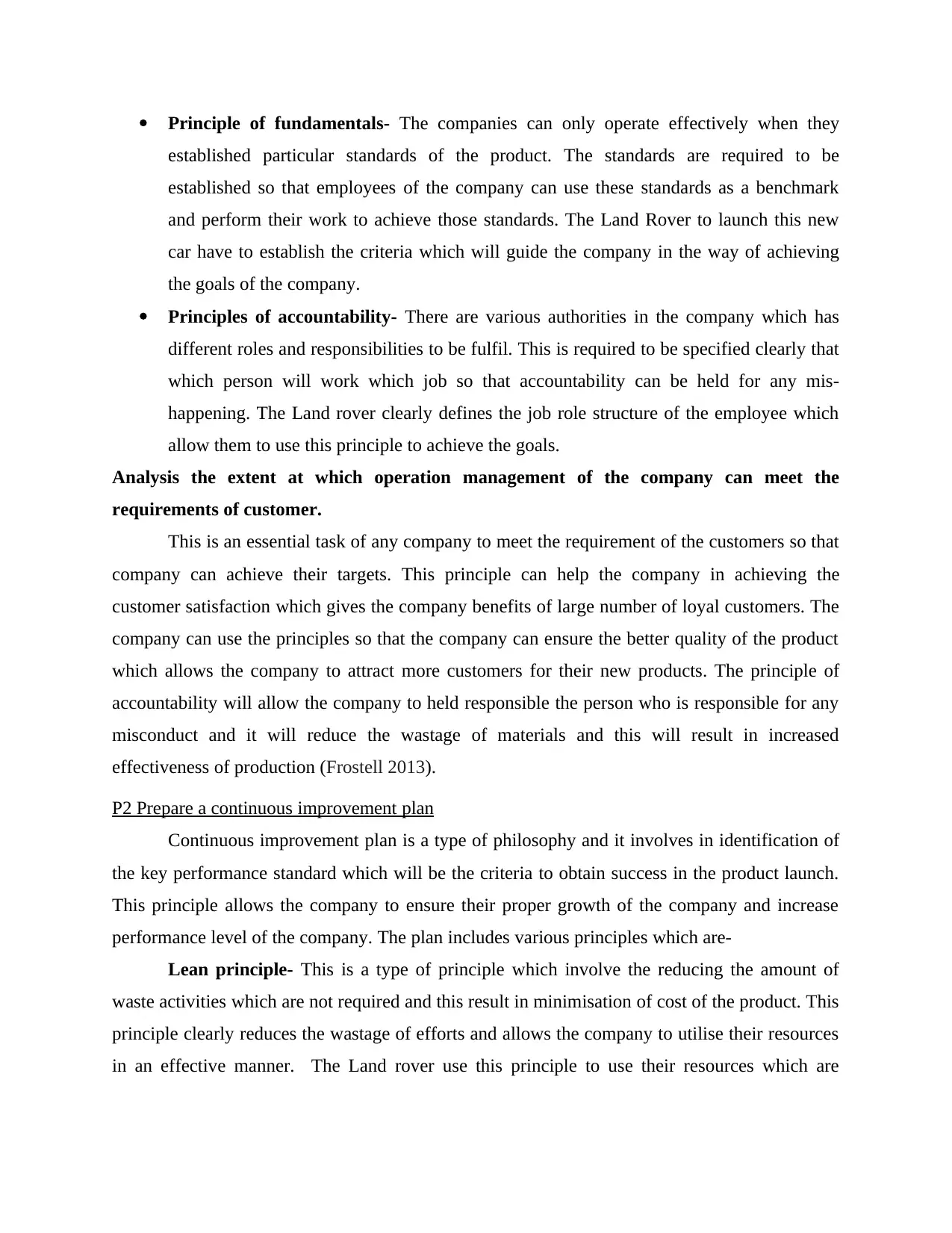
Principle of fundamentals- The companies can only operate effectively when they
established particular standards of the product. The standards are required to be
established so that employees of the company can use these standards as a benchmark
and perform their work to achieve those standards. The Land Rover to launch this new
car have to establish the criteria which will guide the company in the way of achieving
the goals of the company.
Principles of accountability- There are various authorities in the company which has
different roles and responsibilities to be fulfil. This is required to be specified clearly that
which person will work which job so that accountability can be held for any mis-
happening. The Land rover clearly defines the job role structure of the employee which
allow them to use this principle to achieve the goals.
Analysis the extent at which operation management of the company can meet the
requirements of customer.
This is an essential task of any company to meet the requirement of the customers so that
company can achieve their targets. This principle can help the company in achieving the
customer satisfaction which gives the company benefits of large number of loyal customers. The
company can use the principles so that the company can ensure the better quality of the product
which allows the company to attract more customers for their new products. The principle of
accountability will allow the company to held responsible the person who is responsible for any
misconduct and it will reduce the wastage of materials and this will result in increased
effectiveness of production (Frostell 2013).
P2 Prepare a continuous improvement plan
Continuous improvement plan is a type of philosophy and it involves in identification of
the key performance standard which will be the criteria to obtain success in the product launch.
This principle allows the company to ensure their proper growth of the company and increase
performance level of the company. The plan includes various principles which are-
Lean principle- This is a type of principle which involve the reducing the amount of
waste activities which are not required and this result in minimisation of cost of the product. This
principle clearly reduces the wastage of efforts and allows the company to utilise their resources
in an effective manner. The Land rover use this principle to use their resources which are
established particular standards of the product. The standards are required to be
established so that employees of the company can use these standards as a benchmark
and perform their work to achieve those standards. The Land Rover to launch this new
car have to establish the criteria which will guide the company in the way of achieving
the goals of the company.
Principles of accountability- There are various authorities in the company which has
different roles and responsibilities to be fulfil. This is required to be specified clearly that
which person will work which job so that accountability can be held for any mis-
happening. The Land rover clearly defines the job role structure of the employee which
allow them to use this principle to achieve the goals.
Analysis the extent at which operation management of the company can meet the
requirements of customer.
This is an essential task of any company to meet the requirement of the customers so that
company can achieve their targets. This principle can help the company in achieving the
customer satisfaction which gives the company benefits of large number of loyal customers. The
company can use the principles so that the company can ensure the better quality of the product
which allows the company to attract more customers for their new products. The principle of
accountability will allow the company to held responsible the person who is responsible for any
misconduct and it will reduce the wastage of materials and this will result in increased
effectiveness of production (Frostell 2013).
P2 Prepare a continuous improvement plan
Continuous improvement plan is a type of philosophy and it involves in identification of
the key performance standard which will be the criteria to obtain success in the product launch.
This principle allows the company to ensure their proper growth of the company and increase
performance level of the company. The plan includes various principles which are-
Lean principle- This is a type of principle which involve the reducing the amount of
waste activities which are not required and this result in minimisation of cost of the product. This
principle clearly reduces the wastage of efforts and allows the company to utilise their resources
in an effective manner. The Land rover use this principle to use their resources which are
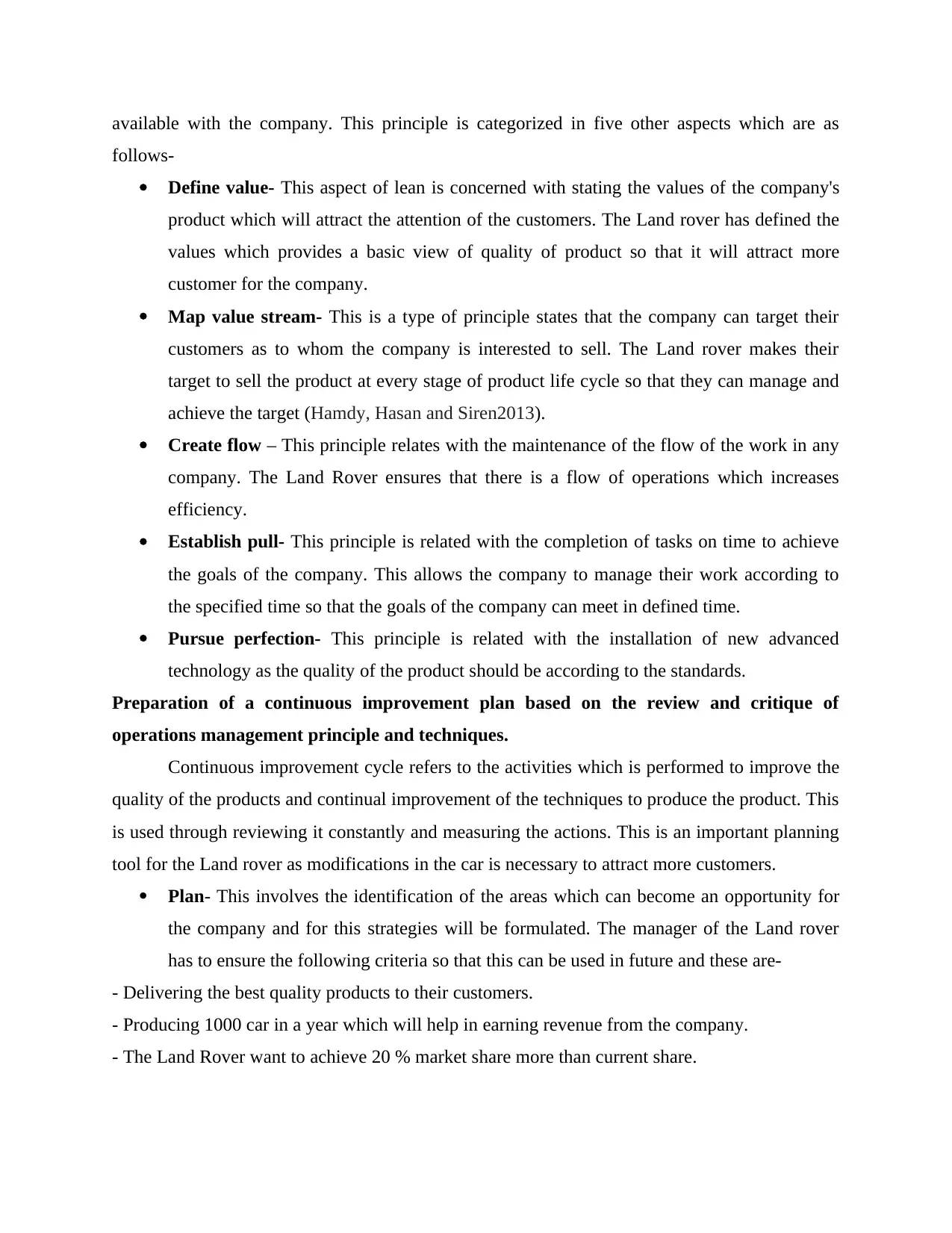
available with the company. This principle is categorized in five other aspects which are as
follows-
Define value- This aspect of lean is concerned with stating the values of the company's
product which will attract the attention of the customers. The Land rover has defined the
values which provides a basic view of quality of product so that it will attract more
customer for the company.
Map value stream- This is a type of principle states that the company can target their
customers as to whom the company is interested to sell. The Land rover makes their
target to sell the product at every stage of product life cycle so that they can manage and
achieve the target (Hamdy, Hasan and Siren2013).
Create flow – This principle relates with the maintenance of the flow of the work in any
company. The Land Rover ensures that there is a flow of operations which increases
efficiency.
Establish pull- This principle is related with the completion of tasks on time to achieve
the goals of the company. This allows the company to manage their work according to
the specified time so that the goals of the company can meet in defined time.
Pursue perfection- This principle is related with the installation of new advanced
technology as the quality of the product should be according to the standards.
Preparation of a continuous improvement plan based on the review and critique of
operations management principle and techniques.
Continuous improvement cycle refers to the activities which is performed to improve the
quality of the products and continual improvement of the techniques to produce the product. This
is used through reviewing it constantly and measuring the actions. This is an important planning
tool for the Land rover as modifications in the car is necessary to attract more customers.
Plan- This involves the identification of the areas which can become an opportunity for
the company and for this strategies will be formulated. The manager of the Land rover
has to ensure the following criteria so that this can be used in future and these are-
- Delivering the best quality products to their customers.
- Producing 1000 car in a year which will help in earning revenue from the company.
- The Land Rover want to achieve 20 % market share more than current share.
follows-
Define value- This aspect of lean is concerned with stating the values of the company's
product which will attract the attention of the customers. The Land rover has defined the
values which provides a basic view of quality of product so that it will attract more
customer for the company.
Map value stream- This is a type of principle states that the company can target their
customers as to whom the company is interested to sell. The Land rover makes their
target to sell the product at every stage of product life cycle so that they can manage and
achieve the target (Hamdy, Hasan and Siren2013).
Create flow – This principle relates with the maintenance of the flow of the work in any
company. The Land Rover ensures that there is a flow of operations which increases
efficiency.
Establish pull- This principle is related with the completion of tasks on time to achieve
the goals of the company. This allows the company to manage their work according to
the specified time so that the goals of the company can meet in defined time.
Pursue perfection- This principle is related with the installation of new advanced
technology as the quality of the product should be according to the standards.
Preparation of a continuous improvement plan based on the review and critique of
operations management principle and techniques.
Continuous improvement cycle refers to the activities which is performed to improve the
quality of the products and continual improvement of the techniques to produce the product. This
is used through reviewing it constantly and measuring the actions. This is an important planning
tool for the Land rover as modifications in the car is necessary to attract more customers.
Plan- This involves the identification of the areas which can become an opportunity for
the company and for this strategies will be formulated. The manager of the Land rover
has to ensure the following criteria so that this can be used in future and these are-
- Delivering the best quality products to their customers.
- Producing 1000 car in a year which will help in earning revenue from the company.
- The Land Rover want to achieve 20 % market share more than current share.
⊘ This is a preview!⊘
Do you want full access?
Subscribe today to unlock all pages.

Trusted by 1+ million students worldwide
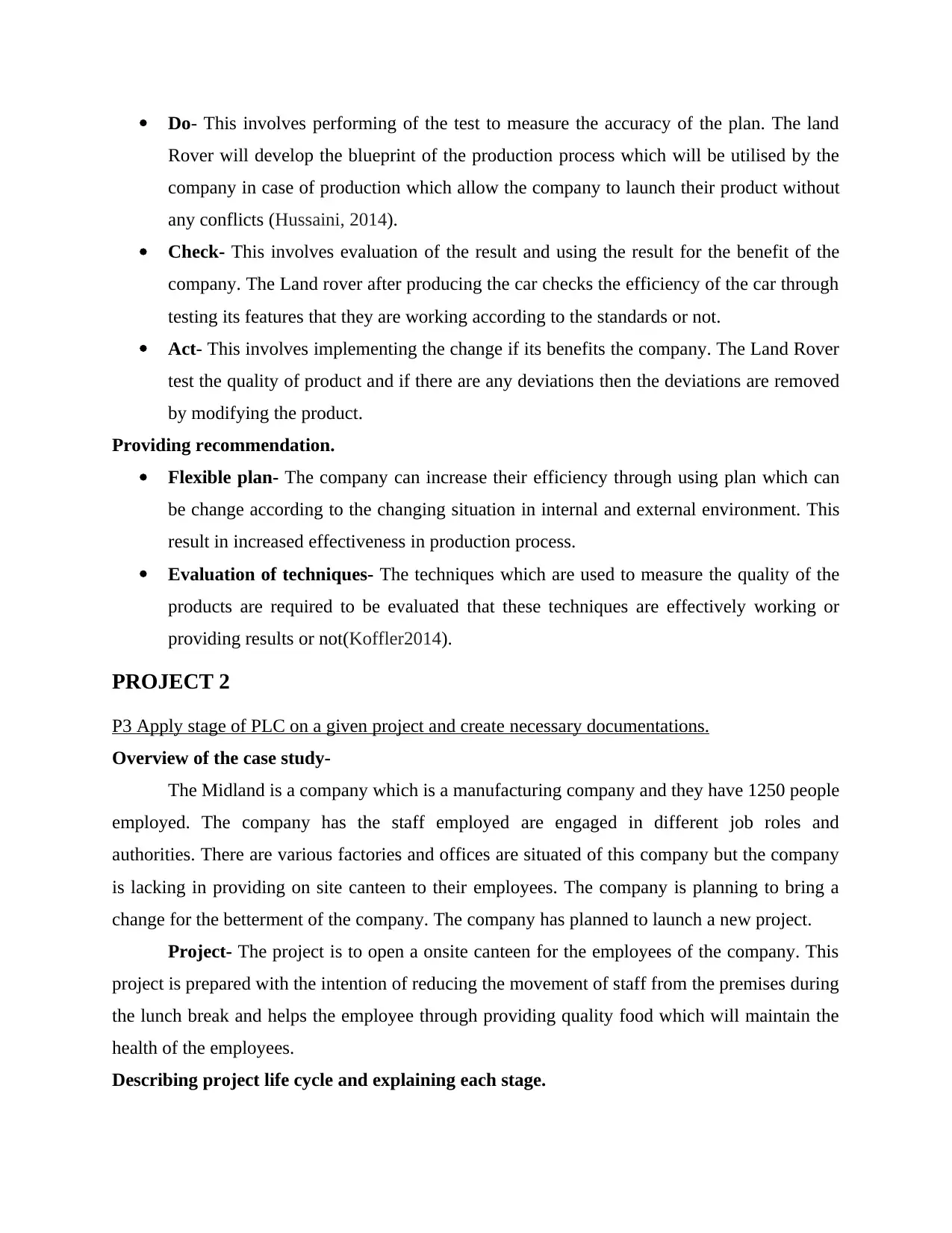
Do- This involves performing of the test to measure the accuracy of the plan. The land
Rover will develop the blueprint of the production process which will be utilised by the
company in case of production which allow the company to launch their product without
any conflicts (Hussaini, 2014).
Check- This involves evaluation of the result and using the result for the benefit of the
company. The Land rover after producing the car checks the efficiency of the car through
testing its features that they are working according to the standards or not.
Act- This involves implementing the change if its benefits the company. The Land Rover
test the quality of product and if there are any deviations then the deviations are removed
by modifying the product.
Providing recommendation.
Flexible plan- The company can increase their efficiency through using plan which can
be change according to the changing situation in internal and external environment. This
result in increased effectiveness in production process.
Evaluation of techniques- The techniques which are used to measure the quality of the
products are required to be evaluated that these techniques are effectively working or
providing results or not(Koffler2014).
PROJECT 2
P3 Apply stage of PLC on a given project and create necessary documentations.
Overview of the case study-
The Midland is a company which is a manufacturing company and they have 1250 people
employed. The company has the staff employed are engaged in different job roles and
authorities. There are various factories and offices are situated of this company but the company
is lacking in providing on site canteen to their employees. The company is planning to bring a
change for the betterment of the company. The company has planned to launch a new project.
Project- The project is to open a onsite canteen for the employees of the company. This
project is prepared with the intention of reducing the movement of staff from the premises during
the lunch break and helps the employee through providing quality food which will maintain the
health of the employees.
Describing project life cycle and explaining each stage.
Rover will develop the blueprint of the production process which will be utilised by the
company in case of production which allow the company to launch their product without
any conflicts (Hussaini, 2014).
Check- This involves evaluation of the result and using the result for the benefit of the
company. The Land rover after producing the car checks the efficiency of the car through
testing its features that they are working according to the standards or not.
Act- This involves implementing the change if its benefits the company. The Land Rover
test the quality of product and if there are any deviations then the deviations are removed
by modifying the product.
Providing recommendation.
Flexible plan- The company can increase their efficiency through using plan which can
be change according to the changing situation in internal and external environment. This
result in increased effectiveness in production process.
Evaluation of techniques- The techniques which are used to measure the quality of the
products are required to be evaluated that these techniques are effectively working or
providing results or not(Koffler2014).
PROJECT 2
P3 Apply stage of PLC on a given project and create necessary documentations.
Overview of the case study-
The Midland is a company which is a manufacturing company and they have 1250 people
employed. The company has the staff employed are engaged in different job roles and
authorities. There are various factories and offices are situated of this company but the company
is lacking in providing on site canteen to their employees. The company is planning to bring a
change for the betterment of the company. The company has planned to launch a new project.
Project- The project is to open a onsite canteen for the employees of the company. This
project is prepared with the intention of reducing the movement of staff from the premises during
the lunch break and helps the employee through providing quality food which will maintain the
health of the employees.
Describing project life cycle and explaining each stage.
Paraphrase This Document
Need a fresh take? Get an instant paraphrase of this document with our AI Paraphraser
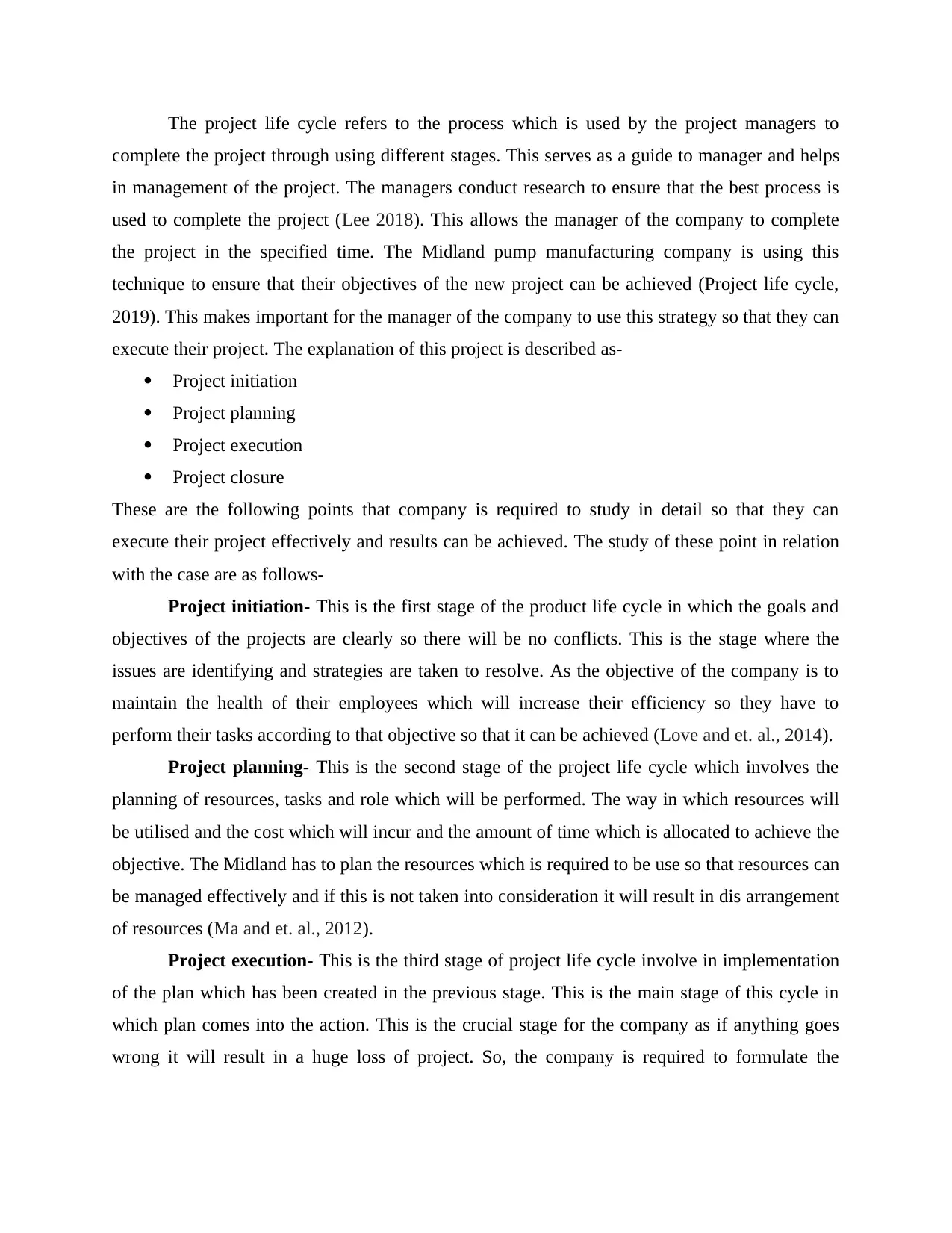
The project life cycle refers to the process which is used by the project managers to
complete the project through using different stages. This serves as a guide to manager and helps
in management of the project. The managers conduct research to ensure that the best process is
used to complete the project (Lee 2018). This allows the manager of the company to complete
the project in the specified time. The Midland pump manufacturing company is using this
technique to ensure that their objectives of the new project can be achieved (Project life cycle,
2019). This makes important for the manager of the company to use this strategy so that they can
execute their project. The explanation of this project is described as-
Project initiation
Project planning
Project execution
Project closure
These are the following points that company is required to study in detail so that they can
execute their project effectively and results can be achieved. The study of these point in relation
with the case are as follows-
Project initiation- This is the first stage of the product life cycle in which the goals and
objectives of the projects are clearly so there will be no conflicts. This is the stage where the
issues are identifying and strategies are taken to resolve. As the objective of the company is to
maintain the health of their employees which will increase their efficiency so they have to
perform their tasks according to that objective so that it can be achieved (Love and et. al., 2014).
Project planning- This is the second stage of the project life cycle which involves the
planning of resources, tasks and role which will be performed. The way in which resources will
be utilised and the cost which will incur and the amount of time which is allocated to achieve the
objective. The Midland has to plan the resources which is required to be use so that resources can
be managed effectively and if this is not taken into consideration it will result in dis arrangement
of resources (Ma and et. al., 2012).
Project execution- This is the third stage of project life cycle involve in implementation
of the plan which has been created in the previous stage. This is the main stage of this cycle in
which plan comes into the action. This is the crucial stage for the company as if anything goes
wrong it will result in a huge loss of project. So, the company is required to formulate the
complete the project through using different stages. This serves as a guide to manager and helps
in management of the project. The managers conduct research to ensure that the best process is
used to complete the project (Lee 2018). This allows the manager of the company to complete
the project in the specified time. The Midland pump manufacturing company is using this
technique to ensure that their objectives of the new project can be achieved (Project life cycle,
2019). This makes important for the manager of the company to use this strategy so that they can
execute their project. The explanation of this project is described as-
Project initiation
Project planning
Project execution
Project closure
These are the following points that company is required to study in detail so that they can
execute their project effectively and results can be achieved. The study of these point in relation
with the case are as follows-
Project initiation- This is the first stage of the product life cycle in which the goals and
objectives of the projects are clearly so there will be no conflicts. This is the stage where the
issues are identifying and strategies are taken to resolve. As the objective of the company is to
maintain the health of their employees which will increase their efficiency so they have to
perform their tasks according to that objective so that it can be achieved (Love and et. al., 2014).
Project planning- This is the second stage of the project life cycle which involves the
planning of resources, tasks and role which will be performed. The way in which resources will
be utilised and the cost which will incur and the amount of time which is allocated to achieve the
objective. The Midland has to plan the resources which is required to be use so that resources can
be managed effectively and if this is not taken into consideration it will result in dis arrangement
of resources (Ma and et. al., 2012).
Project execution- This is the third stage of project life cycle involve in implementation
of the plan which has been created in the previous stage. This is the main stage of this cycle in
which plan comes into the action. This is the crucial stage for the company as if anything goes
wrong it will result in a huge loss of project. So, the company is required to formulate the
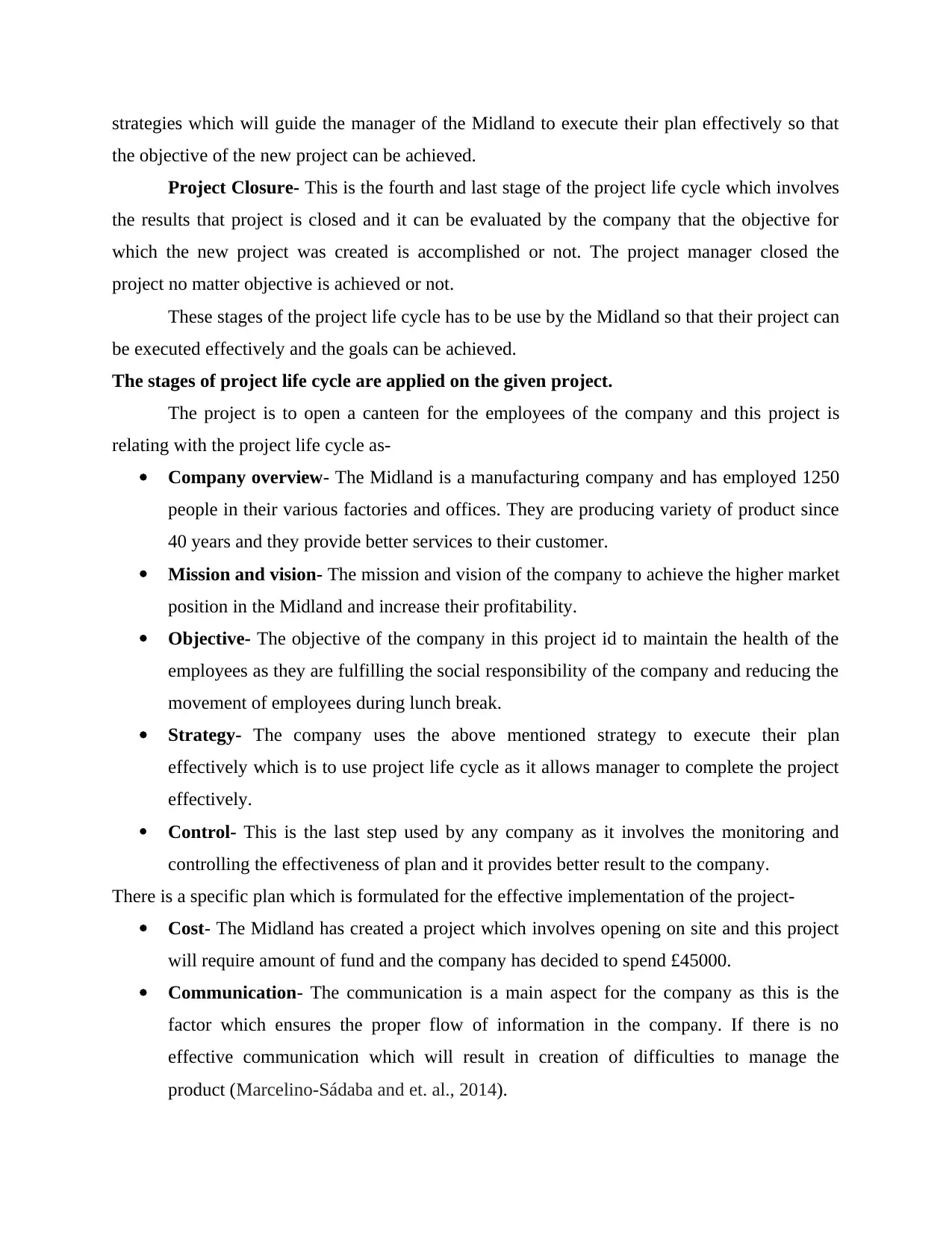
strategies which will guide the manager of the Midland to execute their plan effectively so that
the objective of the new project can be achieved.
Project Closure- This is the fourth and last stage of the project life cycle which involves
the results that project is closed and it can be evaluated by the company that the objective for
which the new project was created is accomplished or not. The project manager closed the
project no matter objective is achieved or not.
These stages of the project life cycle has to be use by the Midland so that their project can
be executed effectively and the goals can be achieved.
The stages of project life cycle are applied on the given project.
The project is to open a canteen for the employees of the company and this project is
relating with the project life cycle as-
Company overview- The Midland is a manufacturing company and has employed 1250
people in their various factories and offices. They are producing variety of product since
40 years and they provide better services to their customer.
Mission and vision- The mission and vision of the company to achieve the higher market
position in the Midland and increase their profitability.
Objective- The objective of the company in this project id to maintain the health of the
employees as they are fulfilling the social responsibility of the company and reducing the
movement of employees during lunch break.
Strategy- The company uses the above mentioned strategy to execute their plan
effectively which is to use project life cycle as it allows manager to complete the project
effectively.
Control- This is the last step used by any company as it involves the monitoring and
controlling the effectiveness of plan and it provides better result to the company.
There is a specific plan which is formulated for the effective implementation of the project-
Cost- The Midland has created a project which involves opening on site and this project
will require amount of fund and the company has decided to spend £45000.
Communication- The communication is a main aspect for the company as this is the
factor which ensures the proper flow of information in the company. If there is no
effective communication which will result in creation of difficulties to manage the
product (Marcelino-Sádaba and et. al., 2014).
the objective of the new project can be achieved.
Project Closure- This is the fourth and last stage of the project life cycle which involves
the results that project is closed and it can be evaluated by the company that the objective for
which the new project was created is accomplished or not. The project manager closed the
project no matter objective is achieved or not.
These stages of the project life cycle has to be use by the Midland so that their project can
be executed effectively and the goals can be achieved.
The stages of project life cycle are applied on the given project.
The project is to open a canteen for the employees of the company and this project is
relating with the project life cycle as-
Company overview- The Midland is a manufacturing company and has employed 1250
people in their various factories and offices. They are producing variety of product since
40 years and they provide better services to their customer.
Mission and vision- The mission and vision of the company to achieve the higher market
position in the Midland and increase their profitability.
Objective- The objective of the company in this project id to maintain the health of the
employees as they are fulfilling the social responsibility of the company and reducing the
movement of employees during lunch break.
Strategy- The company uses the above mentioned strategy to execute their plan
effectively which is to use project life cycle as it allows manager to complete the project
effectively.
Control- This is the last step used by any company as it involves the monitoring and
controlling the effectiveness of plan and it provides better result to the company.
There is a specific plan which is formulated for the effective implementation of the project-
Cost- The Midland has created a project which involves opening on site and this project
will require amount of fund and the company has decided to spend £45000.
Communication- The communication is a main aspect for the company as this is the
factor which ensures the proper flow of information in the company. If there is no
effective communication which will result in creation of difficulties to manage the
product (Marcelino-Sádaba and et. al., 2014).
⊘ This is a preview!⊘
Do you want full access?
Subscribe today to unlock all pages.

Trusted by 1+ million students worldwide
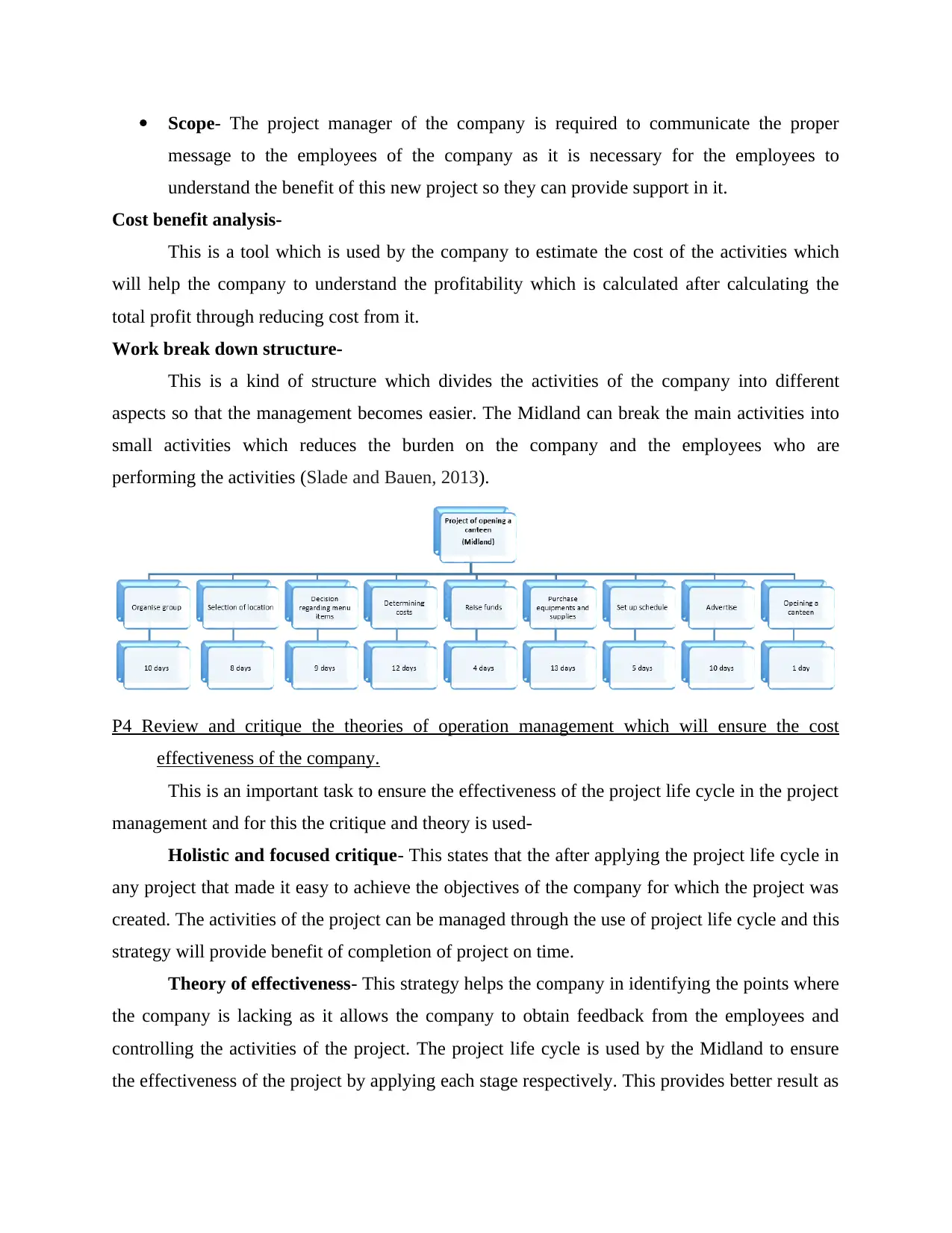
Scope- The project manager of the company is required to communicate the proper
message to the employees of the company as it is necessary for the employees to
understand the benefit of this new project so they can provide support in it.
Cost benefit analysis-
This is a tool which is used by the company to estimate the cost of the activities which
will help the company to understand the profitability which is calculated after calculating the
total profit through reducing cost from it.
Work break down structure-
This is a kind of structure which divides the activities of the company into different
aspects so that the management becomes easier. The Midland can break the main activities into
small activities which reduces the burden on the company and the employees who are
performing the activities (Slade and Bauen, 2013).
P4 Review and critique the theories of operation management which will ensure the cost
effectiveness of the company.
This is an important task to ensure the effectiveness of the project life cycle in the project
management and for this the critique and theory is used-
Holistic and focused critique- This states that the after applying the project life cycle in
any project that made it easy to achieve the objectives of the company for which the project was
created. The activities of the project can be managed through the use of project life cycle and this
strategy will provide benefit of completion of project on time.
Theory of effectiveness- This strategy helps the company in identifying the points where
the company is lacking as it allows the company to obtain feedback from the employees and
controlling the activities of the project. The project life cycle is used by the Midland to ensure
the effectiveness of the project by applying each stage respectively. This provides better result as
message to the employees of the company as it is necessary for the employees to
understand the benefit of this new project so they can provide support in it.
Cost benefit analysis-
This is a tool which is used by the company to estimate the cost of the activities which
will help the company to understand the profitability which is calculated after calculating the
total profit through reducing cost from it.
Work break down structure-
This is a kind of structure which divides the activities of the company into different
aspects so that the management becomes easier. The Midland can break the main activities into
small activities which reduces the burden on the company and the employees who are
performing the activities (Slade and Bauen, 2013).
P4 Review and critique the theories of operation management which will ensure the cost
effectiveness of the company.
This is an important task to ensure the effectiveness of the project life cycle in the project
management and for this the critique and theory is used-
Holistic and focused critique- This states that the after applying the project life cycle in
any project that made it easy to achieve the objectives of the company for which the project was
created. The activities of the project can be managed through the use of project life cycle and this
strategy will provide benefit of completion of project on time.
Theory of effectiveness- This strategy helps the company in identifying the points where
the company is lacking as it allows the company to obtain feedback from the employees and
controlling the activities of the project. The project life cycle is used by the Midland to ensure
the effectiveness of the project by applying each stage respectively. This provides better result as
Paraphrase This Document
Need a fresh take? Get an instant paraphrase of this document with our AI Paraphraser
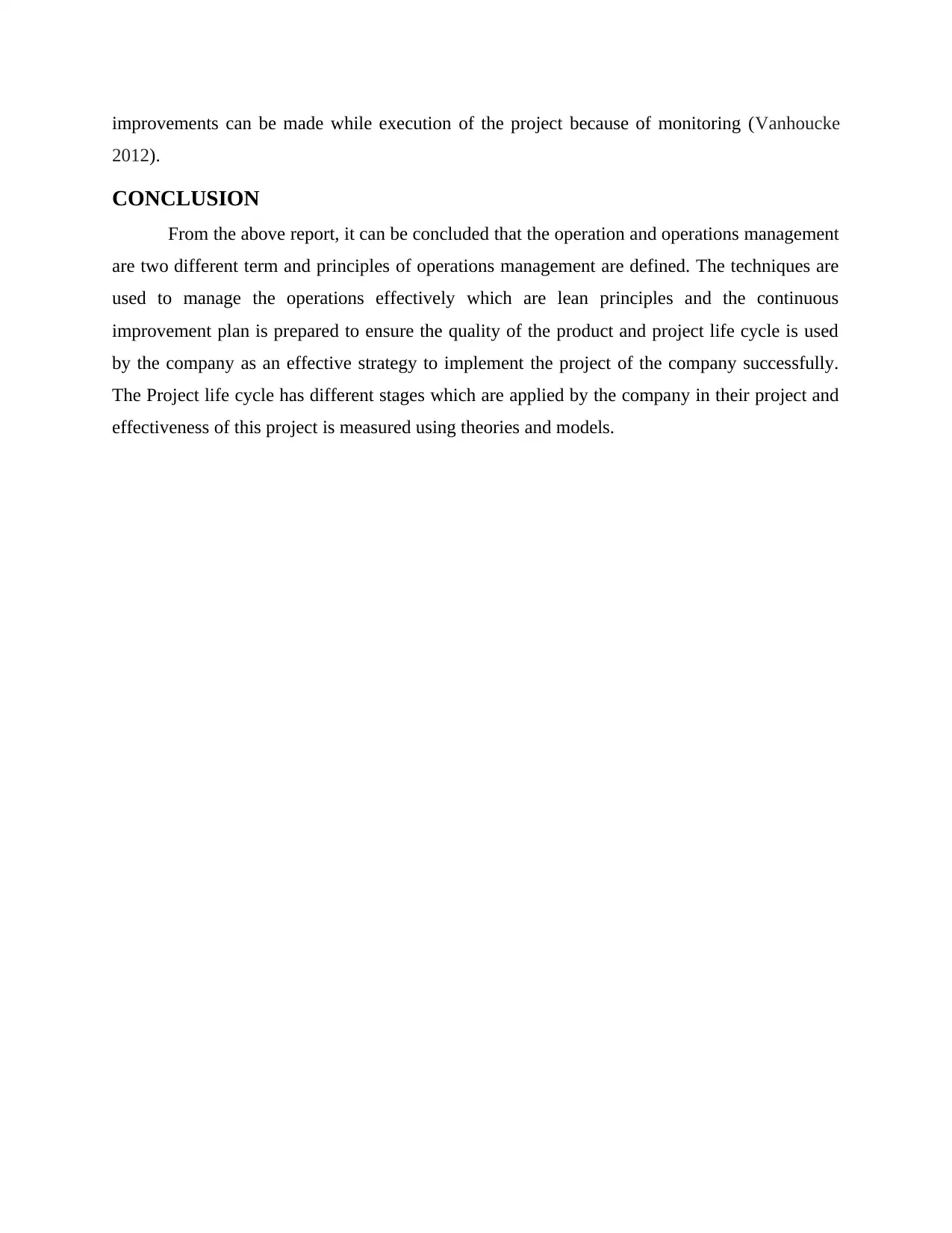
improvements can be made while execution of the project because of monitoring (Vanhoucke
2012).
CONCLUSION
From the above report, it can be concluded that the operation and operations management
are two different term and principles of operations management are defined. The techniques are
used to manage the operations effectively which are lean principles and the continuous
improvement plan is prepared to ensure the quality of the product and project life cycle is used
by the company as an effective strategy to implement the project of the company successfully.
The Project life cycle has different stages which are applied by the company in their project and
effectiveness of this project is measured using theories and models.
2012).
CONCLUSION
From the above report, it can be concluded that the operation and operations management
are two different term and principles of operations management are defined. The techniques are
used to manage the operations effectively which are lean principles and the continuous
improvement plan is prepared to ensure the quality of the product and project life cycle is used
by the company as an effective strategy to implement the project of the company successfully.
The Project life cycle has different stages which are applied by the company in their project and
effectiveness of this project is measured using theories and models.
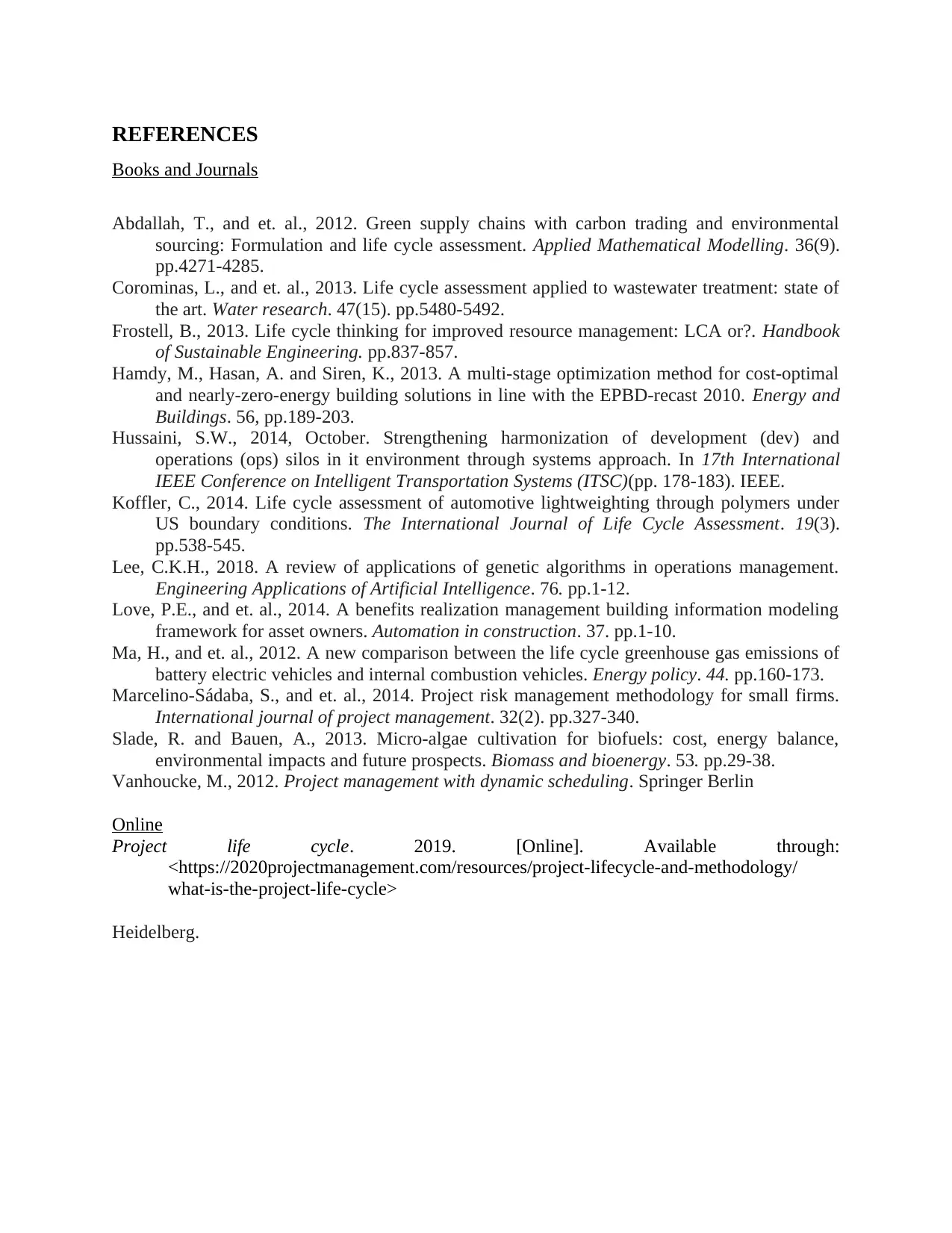
REFERENCES
Books and Journals
Abdallah, T., and et. al., 2012. Green supply chains with carbon trading and environmental
sourcing: Formulation and life cycle assessment. Applied Mathematical Modelling. 36(9).
pp.4271-4285.
Corominas, L., and et. al., 2013. Life cycle assessment applied to wastewater treatment: state of
the art. Water research. 47(15). pp.5480-5492.
Frostell, B., 2013. Life cycle thinking for improved resource management: LCA or?. Handbook
of Sustainable Engineering. pp.837-857.
Hamdy, M., Hasan, A. and Siren, K., 2013. A multi-stage optimization method for cost-optimal
and nearly-zero-energy building solutions in line with the EPBD-recast 2010. Energy and
Buildings. 56, pp.189-203.
Hussaini, S.W., 2014, October. Strengthening harmonization of development (dev) and
operations (ops) silos in it environment through systems approach. In 17th International
IEEE Conference on Intelligent Transportation Systems (ITSC)(pp. 178-183). IEEE.
Koffler, C., 2014. Life cycle assessment of automotive lightweighting through polymers under
US boundary conditions. The International Journal of Life Cycle Assessment. 19(3).
pp.538-545.
Lee, C.K.H., 2018. A review of applications of genetic algorithms in operations management.
Engineering Applications of Artificial Intelligence. 76. pp.1-12.
Love, P.E., and et. al., 2014. A benefits realization management building information modeling
framework for asset owners. Automation in construction. 37. pp.1-10.
Ma, H., and et. al., 2012. A new comparison between the life cycle greenhouse gas emissions of
battery electric vehicles and internal combustion vehicles. Energy policy. 44. pp.160-173.
Marcelino-Sádaba, S., and et. al., 2014. Project risk management methodology for small firms.
International journal of project management. 32(2). pp.327-340.
Slade, R. and Bauen, A., 2013. Micro-algae cultivation for biofuels: cost, energy balance,
environmental impacts and future prospects. Biomass and bioenergy. 53. pp.29-38.
Vanhoucke, M., 2012. Project management with dynamic scheduling. Springer Berlin
Online
Project life cycle. 2019. [Online]. Available through:
<https://2020projectmanagement.com/resources/project-lifecycle-and-methodology/
what-is-the-project-life-cycle>
Heidelberg.
Books and Journals
Abdallah, T., and et. al., 2012. Green supply chains with carbon trading and environmental
sourcing: Formulation and life cycle assessment. Applied Mathematical Modelling. 36(9).
pp.4271-4285.
Corominas, L., and et. al., 2013. Life cycle assessment applied to wastewater treatment: state of
the art. Water research. 47(15). pp.5480-5492.
Frostell, B., 2013. Life cycle thinking for improved resource management: LCA or?. Handbook
of Sustainable Engineering. pp.837-857.
Hamdy, M., Hasan, A. and Siren, K., 2013. A multi-stage optimization method for cost-optimal
and nearly-zero-energy building solutions in line with the EPBD-recast 2010. Energy and
Buildings. 56, pp.189-203.
Hussaini, S.W., 2014, October. Strengthening harmonization of development (dev) and
operations (ops) silos in it environment through systems approach. In 17th International
IEEE Conference on Intelligent Transportation Systems (ITSC)(pp. 178-183). IEEE.
Koffler, C., 2014. Life cycle assessment of automotive lightweighting through polymers under
US boundary conditions. The International Journal of Life Cycle Assessment. 19(3).
pp.538-545.
Lee, C.K.H., 2018. A review of applications of genetic algorithms in operations management.
Engineering Applications of Artificial Intelligence. 76. pp.1-12.
Love, P.E., and et. al., 2014. A benefits realization management building information modeling
framework for asset owners. Automation in construction. 37. pp.1-10.
Ma, H., and et. al., 2012. A new comparison between the life cycle greenhouse gas emissions of
battery electric vehicles and internal combustion vehicles. Energy policy. 44. pp.160-173.
Marcelino-Sádaba, S., and et. al., 2014. Project risk management methodology for small firms.
International journal of project management. 32(2). pp.327-340.
Slade, R. and Bauen, A., 2013. Micro-algae cultivation for biofuels: cost, energy balance,
environmental impacts and future prospects. Biomass and bioenergy. 53. pp.29-38.
Vanhoucke, M., 2012. Project management with dynamic scheduling. Springer Berlin
Online
Project life cycle. 2019. [Online]. Available through:
<https://2020projectmanagement.com/resources/project-lifecycle-and-methodology/
what-is-the-project-life-cycle>
Heidelberg.
⊘ This is a preview!⊘
Do you want full access?
Subscribe today to unlock all pages.

Trusted by 1+ million students worldwide
1 out of 12
Related Documents
Your All-in-One AI-Powered Toolkit for Academic Success.
+13062052269
info@desklib.com
Available 24*7 on WhatsApp / Email
![[object Object]](/_next/static/media/star-bottom.7253800d.svg)
Unlock your academic potential
Copyright © 2020–2025 A2Z Services. All Rights Reserved. Developed and managed by ZUCOL.





